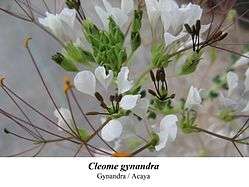Cleome gynandra
| Cleome gynandra | |
|---|---|
 | |
| Scientific classification | |
| Kingdom: | Plantae |
| (unranked): | Angiosperms |
| (unranked): | Eudicots |
| (unranked): | Rosids |
| Order: | Brassicales |
| Family: | Cleomaceae |
| Genus: | Cleome |
| Species: | C. gynandra |
| Binomial name | |
| Cleome gynandra L. | |
| Synonyms[1] | |
| |
Cleome gynandra is a species of Cleome that is used as a green vegetable. It is known by many common names including Shona cabbage,[2] African cabbage, spiderwisp, cat's whiskers,[3] chinsaga and stinkweed.[4] It is an annual wildflower native to Africa but has become widespread in many tropical and sub-tropical parts of the world.[5] It is an erect, branching plant generally between 25 cm and 60 cm tall. Its sparse leaves are each made up of 3-5 oval-shaped leaflets. The flowers are white, sometimes changing to rose pink as they age.[6] The seed is a brown 1.5 mm diameter sphere. The leaves and flowers are both edible. The leaves have a strong bitter, sometimes peppery flavor similar to mustard greens.
Uses

Typically, the leaves and shoots are eaten boiled or in stews. The leaves form an important part of diets in Southern Africa,[6] while in Thailand the leaves are a popular food item fermented with rice water as a pickle known as phak sian dong.[7]
Nutritional analyses have found it to be high in certain nutrients including beta-carotene, folic acid, ascorbic acid and calcium. It also contains vitamin E, iron, and oxalic acid. Generally, the leaves are about 4.0% protein. The leaves also have antioxidative properties that can help with inflammatory diseases.[5]
Because of its anti-inflammatory properties, it is sometimes used as a medicinal herb.[8]
Vernacular names
In English, there are several names including African spider plant, cat's whisker's spider flower, and spiderwisp. In French, it's referred to as feuilles caya or mozambe, while in Spanish it's called volatin, masambey, or jasmin de rio.[5]
In several African countries, it is simply referred to as spinach or wild spinach (not to be confused with spinach), though it does have specific names. In Telugu, C. gynandra is termed as Vaminta or Vayinta. Marathi (Tilavan); Kenyan (Kisii): Chinsaga; (Luo): Dek, shwetahudhude in Bengali, Phak Sian (ผักเสี้ยน) in Thai. In Shona it is known as "munyevhe". In Zulu, it is called "ulude".[8]
Ecology
It is an annual wildflower native to Africa but has naturalized across tropic and sub-tropical regions across Asia.[5] It grows well in disturbed, well-drained soils, but is also drought-tolerant. It does not tolerate cold temperatures well, and is frost-tender.
Cleome gynandra is considered an invasive weed in many places in the U.S.[9] and elsewhere in the Pacific.[10]
Biochemistry
Cleome gynandra uses NAD-malic enzyme type C4 photosynthesis and has the characteristic traits associated with this including changes in "leaf biochemistry, cell biology and development".[11] Cleome gynandra is closely related to Arabidopsis thaliana (a C3 photosynthetic plant) and therefore offers comparison with this well studied model organism.
See also
References
- ↑ "The Plant List: A Working List of All Plant Species". Retrieved January 26, 2014.
- ↑ "dict.cc dictionary :: Shona cabbage :: German-English translation". www.dict.cc. Retrieved 2016-07-19.
- ↑ "Gynandropsis gynandra (L.) Briq.", USDA GRIN Taxonomy, retrieved 28 July 2015
- ↑ http://raisingislands.blogspot.com.au/2015/11/natural-pesticides-from-common-weed.html
- 1 2 3 4 "Spider plant (Cleome gynandra) - World Vegetable Center". World Vegetable Center. 2016-04-25. Retrieved 2016-07-19.
- 1 2 Cleome gynandra L. entry in Plantzafrica database
- ↑ ผักเสี้ยน สรรพคุณและประโยชน์ของผักเสี้ยน 29 ข้อ !
- 1 2 "Cleome gynandra African Spider Flower, Spiderwisp PFAF Plant Database". www.pfaf.org. Retrieved 2016-07-19.
- ↑ USDA-NRCS: Invasive and noxious weeds
- ↑ Cleome gynandra: Plant threats to Pacific ecosystems (Pacific Island Ecosystems at Risk project (PIER))
- ↑ Marshall, D.M., Muhaidat, R., Brown, N.J., Liu, Z., Stanley, S., Griffiths, H.G., Sage, R.F., Hibberd, J.M. (2007) Cleome, a genus closely related to Arabidopsis, contains species spanning a developmental progression from C3 to C4 photosynthesis. Plant Journal, 51: 886-896
External links
| Wikimedia Commons has media related to Cleome gynandra. |